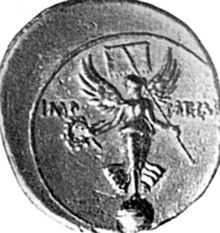Removal
The altar was removed from the curia by the emperor Constantius II in 357. It was later restored by the emperor Julian, who was the only emperor after the conversion of Constantine I to adhere to the traditional religion of Rome. The altar was again removed by Gratian in 382.
After Gratian's death, Quintus Aurelius Symmachus, a senator and Prefect of Rome who sought to preserve Rome's religious traditions, in 384 wrote to the new emperor Valentinian II requesting the restoration of the altar. [3] In the imperial court in Milan, the young emperor denied the request. Ambrose, Bishop of Milan successfully persuaded Valentinian to resist the request to preserve the altar. [4] However, he was not the main person behind the resolution that removed the altar though he did participate in the debate. [5]
Further petitions to restore the altar were deflected in 391 by an edict of the emperor Theodosius I as part of his efforts to ensure that Christianity was the only religion practised in the Empire. The altar was restored by Eugenius during his short-lived rule (392–394), according to Paulinus of Milan in his Life of Ambrose.
Writing in 403, Claudian mentioned that the statue (if not the altar) was then in the Senate House. [6] Sheridan states "Some think that removals and restorations refer to both the Altar of Victory and the Statue of Victory. Others think that the Statue was never removed from its place. There is no statement in the ancient authors as to what happened to the Statue when the Altar was removed and certainty on this point is unattainable." [7]
Sheridan further suggests that "the fate of the Altar and Statue of Victory was finally sealed by the law of 408 against heathen statues," citing Codex Theodosianus XVI,10, 19. [8]
This page is based on this
Wikipedia article Text is available under the
CC BY-SA 4.0 license; additional terms may apply.
Images, videos and audio are available under their respective licenses.
